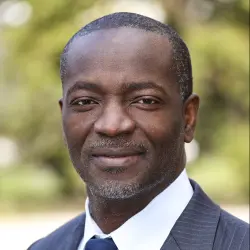This week, President Biden will convene 40 world leaders for a major climate conference. The event marks America’s return to the world stage on climate action and is an opportunity for the president to work with other global leaders on fighting an existential crisis that has already wreaked havoc across the world.
In a series of videos, Brookings scholars provided their thoughts on the conference and their hopes on what may come of it. Below is a lightly edited transcript of their remarks. (Editor’s Note: On April 22, after these videos were produced, President Biden announced a U.S. pledge to reduce greenhouse gas emissions up to 52% by 2030.)
Brahima Coulibaly
Vice President and Director, Global Economy and Development

There is broad consensus that collective action to address climate change has fallen significantly short in the past few years, and that the next few years represent a critical last chance window of opportunity to ramp it up at all levels. The U.S. was absent from the global arena for the past four years, as climate was not a priority for the Trump administration. But by making climate change a stronger and urgent priority, beginning with a return to the Paris Agreement on their first day in office, the Biden administration signals both a major shift in the U.S. domestic climate policy and the return of U.S. engagement and leadership to the climate agenda.
This year represents a pivotal year, in part because countries are ramping up efforts to build back their economies, which have been devastated by the pandemic. Policymakers have an opportunity here to simultaneously tackle the pandemic and the climate crisis by making massive investments in a green infrastructure as part of their reconstruction efforts, and make a leap forward on their ambitions to build climate resilient economies.
At the conference, which convenes countries responsible for 80 percent of global emissions and global GDP, I hope to see a strong consensus emerge on the imperative of raising ambition, and importantly also a credible commitment to deliver on those ambitions. Delivering on the climate agenda will require buy-in from all stakeholders. It is reassuring to see that the administration has involved business and civil society leaders.
Samantha Gross
Director, Energy Security and Climate Initiative
Fellow, Foreign Policy, Energy Security and Climate Initiative

I’m excited to see the new U.S. nationally determined contribution (NDC) and our new set of commitments under the Paris Agreement. I expect that President Biden will put out a quite ambitious NDC—the world certainly expects it of him, as do environmentalists in the United States. But more than what’s on the front page and our frontline promise, I’m really wondering what we’re going to see behind that—the kinds of policies and programs that are proposed to support the kinds of emissions reductions that we’re looking for. It’s going to be difficult to get any kind of comprehensive climate legislation through Congress, and so I look to these programs as being a real combination of things that the administration can do itself through executive orders, actions under existing laws, and then maybe a combination of carrots that we might be able to get through Congress. Everybody likes carrots—R&D spending, spending on climate friendly infrastructure, investments in clean power, and also in cleaner industry. And so, I expect to see this kind of combination of things add up to make the U.S. NDC. But beyond the top line, what I really want to see is what’s next for U.S. climate policy.
Nathan Hultman
Nonresident Senior Fellow, Global Economy and Development

This year on Earth Day, President Biden will be convening world leaders for a climate leaders’ summit. President Biden has at least two goals out of this summit. The first one is to have a conversation with the key emitters around the world and the key economic powers of the world to better understand how they can collaborate and work together, and then deliver on more ambitious climate action—not only in their countries, but to support climate action across the world with an eye toward the COP26 conference later this year in Glasgow.
The second goal Biden has is to reintroduce the United States as a world leader on climate change. As we all know, the United States has taken a step back at the federal level over the past four years. With the 2020 election, there’s now climate leadership in both the Congress and the executive branch. President Biden is very eager to show that the U.S. is rejoining the ranks of leadership for climate change and doing it in a big way.
There is one critical element for success for this summit that has to happen. The critical element, of course, is the U.S. telling the world what it will be doing domestically to address climate change. That will likely come in the form of a climate target that is invited by all parties under the Paris Agreement. So, the U.S. will be announcing a target of its own, probably some days before the summit, that will signal to the world the level of ambition that the U.S. has domestically. By getting our own house in order and by conveying that to the world, President Biden will have a much stronger position from which to convene and have discussions with world leaders. And that will hopefully lead to a more ambitious outcome from the summit.
Joseph Kane
Senior Research Associate and Associate Fellow, Metropolitan Policy Program

Obviously, this climate summit sends a strong global signal about the U.S.’s role and hopefully its leadership on climate issues when it comes planning and executing on greenhouse gas emission reduction targets. And, it’s a reset of sorts with the Biden administration rejoining the Paris climate agreement and taking steps towards a net zero economy.
What I’m most interested and curious about on this global stage is to what extent certain domestic priorities will come up. And there’s two categories of domestic priorities that that I’ll be looking for. The first is infrastructure—not just energy infrastructure, but our transportation infrastructure, our water infrastructure, how we manage our land. These are central elements to how we not only mitigate an extreme climate, but actually adapt to a changing climate and boost resilience. These are all central elements in the American Jobs Plan, the $2 trillion, eight-year plan that the administration just came out with. So, I imagine this is a big priority that should come up in this summit.
The second priority I will be looking for is where people center in these conversations. We know there are these massive infrastructure investments, potentially these big projects that can make a difference. But how are we targeting our efforts? How are we measuring progress? How are environmental justice issues, workforce development issues, technological issues, the just transition of fossil fuel communities—how are those all coming up in these conversations? These are things that different people in different places need to feel empowered in their capacity to address climate challenges—they should not simply be overlooked.
So, these are two big domestic areas of action that that I’ll be looking for. I would like to see not just a global and national perspective on these issues, but the state and local components too.
Christina Kwauk
Nonresident Fellow, Global Economy and Development, Center for Universal Education

President Biden’s Leaders’ Summit on Climate is an important demonstration of the U.S.’s return to global climate action. But a key theme that’s missing from the agenda is action for climate empowerment through education and training, especially for girls and women. Research suggests that education for climate action, delivered to just 16 percent of secondary students and middle-income and high-income countries, could alone reduce carbon emissions by 2050 by nearly 20 gigatons. Imagine if children, youth, and adults around the world were to receive such an education.
Research also suggests that the education of girls and women, together with addressing an unmet need for family planning, could also help to avoid 85 gigatons of carbon dioxide by 2050. So, education—and especially for girls and women—is a powerful climate solution. But it’s notably absent from the climate agenda.
Article 12 of the Paris Agreement calls on governments to ensure that society can contribute as both citizens and consumers to local global efforts to address the climate crisis. But we cannot empower society if the majority of the world’s population continues to be oppressed by systems and structures of patriarchy, racism, and the legacies of colonialism. President Biden has emphasized the need for green job creation to support a just transition to a clean energy economy, but without a new green learning agenda aimed at equipping all of us with the knowledge, skills, and attitudes for a gender equal future, some of us won’t get there, and as a consequence, we will all lose in this climate crisis. So, the Leaders’ Summit on Climate must address the need for a new green learning agenda, and President Biden and the 40 world leaders coming to this must talk about the role of education and training for climate action.
Sanjay Patnaik
Director, Center on Regulation and Markets
Bernard L. Schwartz Chair in Economic Policy Development
Fellow, Economic Studies

It is very exciting to see that President Biden is putting together a global climate summit with 40 world leaders on April 22nd and 23rd. I believe that this is a very important signal to the rest of the world that the U.S. is back at the table when it comes to climate change, and it will facilitate a lot of high level discussions that can pave the way for more detailed negotiations at the climate conference at the end of the year at COP26. I think what would be really critical for President Biden, however, is to show that the United States is actually committed—and credibly committed—to reducing greenhouse gas emissions and showing a way forward on how to achieve any emissions reductions goal that the U.S. has committed to.
What kind of domestic policy instruments will the Biden administration use to actually reduce emissions? What kind of policy instruments and regulations will have a long-lasting effect so that our international partners know that in a few years we are still on our emissions trajectory? I think given the swings back and forth on climate policy in the United States over the past few years, this would be the most important issue at the conference. But nevertheless, it is a really encouraging sign that the U.S. is taking on leadership again in climate change and working together closely with some of the international partners that have already done a lot in that space, such as the European Union.









Commentary
What to expect from Biden’s first climate conference
April 21, 2021